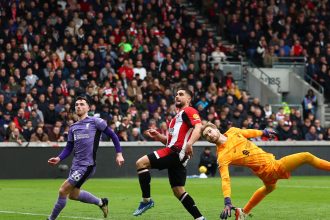The USL League One club has pieced together a truly memorable brand ahead of its debut season
It was Nov. 22, 2022, and Monument Square in Portland, Maine was packed. Some 2,500 people had gathered in the rain to watch the broadcast of a World Cup fixture between England and the United States on a giant screen. In most states, people would have stayed home. But the fans in Portland came out in droves. Perfect weather for soccer.
The scoreline? A drab 0-0, a draw that suited both teams in the group stages. But for Gabe Hoffman-Johnson, organizer of the day and founder of new USL club Portland Hearts of Pine, the goalless affair was irrelevant. That event, instead, was just one of many catalysts that helped his team get off the ground.
This whole thing is about community, trying to encapsulate the very essence of what Maine is – something Mainers insist is not very easy – and piece together a brand that both locals and the wider soccer consciousness can be captivated by. The result is a soccer team that is simultaneously authentic and cool, sincere and hipster – and etching itself into the American sports landscape in its debut season.
“I think part of what I feel like we're building here is a lifestyle brand that just happens to be a pro soccer team,” Hoffman-Johnson explained. “There’s a recognition of that, that we’re trying to cultivate.”
Bill TrevaskisThe buzz
The kits have gone viral. Alternating hoops of green and blue, complete with a collar. There’s an L.L. Bean sponsor on the shirt sleeve. “Lead with your heart” is etched onto the back. They were promoted with a strong social media campaign that included men and women, young and old, styling this thing. Here is a gruff man layering the jersey over a white shirt in the middle of chopping wood. There are kids hanging off a crossbar. A girl standing in a forest, posing for the camera.
And that marketing campaign was, of course, intentional. The design of the jersey appeals to the soccer aficionados. But the way they were presented – complete with the people wearing the kits – was intended to relate to the community. Nerds and locals alike wanted a jersey they could get behind.
But it’s more than just something that looks cool on social media. This whole thing was started by Mainers, built from the ground up through conversations in bars and pickup games in futsal courts. These are not easy people to please, Hoffman-Johnson admits. He has spent more than five years trying to make them happy. He might just have done it.
“If we’re gonna adequately build the best possible lower division soccer franchise to represent our sense of place, like, it can't be coming from my f*cking head only, right?” he said. “There needs to be other people that have a seat at that table.”
AdvertisementGabe Hoffman-JohnsonThe beginning
It was 2018, and Hoffman-Johnson was tired of his job. The former college soccer and USL midfielder had spent two years of hard graft in New York City in the finance sector. He felt something new needed to happen. There were options, but he felt a true calling to Maine, a place he moved to while in middle school. Community soccer had always appealed, he said, and he identified the USL as an ideal outlet to apply his interest.
“I was in that late 20s, ‘OK, what am I gonna do with the rest of my life?’ “ he said. “When the USL announced this new league targeting tertiary-sized cities, I moved home. And 2018 was the first time where I was like, ‘You know, Portland needs a soccer club, and I'm the person to make it happen.’ “
So he secured the rights to a team. And that was about all he had.
Then, it was time for everything else. He and Burke Cherrie had been flirting with the idea of starting a club for a while. Cherrie was an accomplished designer and NYU film school graduate with a history in soccer creative content. He knew the landscape and was brimming with ideas and inspiration. His priority, though, was to create something authentic.
“One thing that's like, very true about Mainers is they f*cking tell you what they think,” Cherrie said. “No one’s gonna be like, ‘Oh yeah, I like your shirt.’ They’d be like ‘That's a stupid f*cking shirt’ if they don't like it. So we knew throughout this process that we had this really active community.”
Bill TrevaskisThe name
Cherrie and Hoffman-Johnson spent the large part of three years sharing ideas back and forth over Instagram. They had color schemes in mind, points of inspiration from other USL clubs, and a shared interest in the beautiful game.
“I think that Gabe and I have very similar sensibilities in terms of what we like around brands,” Cherrie said. “And we talked a lot about inspiration within the league: Oakland Roots and some of these brands that have done it the right way, and basically, how do we create that same mirror to the communities and culture of Maine?”
Hoffman-Johnson had been flirting with ideas. He put out four capsule collections that featured Maine-heavy designs. There was a buzz around it, he felt, but getting the exact name right was a real struggle.
“I think there was a large interest in not being a basic, boring, annoying, unoriginal, club name, which – when you're searching for novelty – can be difficult,” Hoffman-Johnson admitted. “There was a three-year time period where I was like, ‘What the hell are we gonna name this thing?’ “
Part of the problem was they knew the locals almost too well. There was a pressure to get it right, an understanding that they couldn’t be inauthentic to the people they were marketing to.
In the end, the name was the most deeply embedded community reference they could find. The “hearts” part is not a rip off of the Scottish club Hearts of Midlothian, Hoffman-Johnson emphasized. Instead, it’s a reference to a Valentine’s Day tradition in which a local resident – dubbed the “Valentine’s Day bandit” – used to put up hearts around the city. He passed away in 2023, but residents of Portland have upheld tradition.
The “pine” bit is a bit more self-explanatory – derived from the moniker of Maine, “The Pine Tree State.” But Cherrie insists there’s a deeper meaning in that, too.
“A pine is a very soft tree, and it's got this extreme flexibility,” Cherrie said. “It's 100 degrees in the summer, and it's freezing right now, and they grow on cliffs, on tiny islands that barely have any soil. They’re a really hardy tree, even though they kind of got this, like, flexible, malleable center. So there was symbolism and storytelling just kind of running through that.”
And making the name plural was simple. This club is for everyone.
“The only thing we were talking about is if it should be ‘heart’ or ‘hearts.’ We ended up with Hearts of Pine because it represented the community and the collective, versus the singular,” Cherrie explained.
Bill TrevaskisThe badge
Football badges were getting boring. Rebrands to Premier League teams had seen dramatic scenes reduced to tiny characters. Liverpool's once included references to Anfield, the city and the famous Liverbird, all wrapped into one, had been reduced to a stylized bird. These days, Chelsea's is just a lion. That annoyed the duo.
“The way everything now is going – it almost feels like a stamp,” Cherrie said. “It's all a single icon. And felt it was really important to kind of represent a couple things. The way we were talking about the brand was ‘modern retro Maine.’ “
What they came up with is a pretty compelling attempt at summarizing the essence of the place. There’s a Dirigo heart in the upper left, designed after the star on the seal of Maine. There’s water in the corner as a nod to the fishing industry. And, of course, the pine tree on the right pops.
“We had three essential ingredients, and we couldn't do, like, the modern Chelsea badge, which is just a lion. We could have done just a heart. We experimented with all these different directions,” Cherrie said.
They became obsessive. The original mood board was developed in August 2023, but they couldn’t get it right. Various designers came and went before an unlikely candidate stepped in. An owner of a chain of cannabis shops had been bugging the duo for months. They finally gave in – and he provided a crucial moment of inspiration. Another designer friend of theirs, who now lives in Mexico, added the finishing touches to the badge as it appears today.
But, perhaps predictability, that still wasn't quite enough. Cherrie and Hoffman-Johnson were tweaking colors and details a week before the badge was revealed.
“I think there's probably still things where I'm like ‘I wish we had done that.’” Cherrie said. “But we just literally ran out of time. We're like, ‘We gotta finish this brand. We can keep molding this clay forever, but it's gonna dry.’ “






